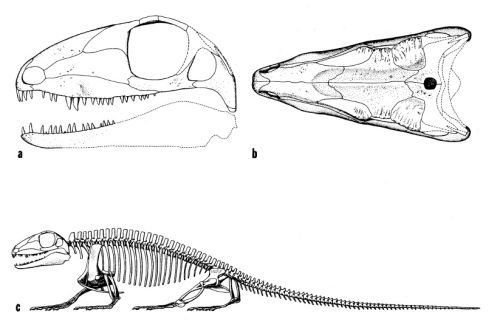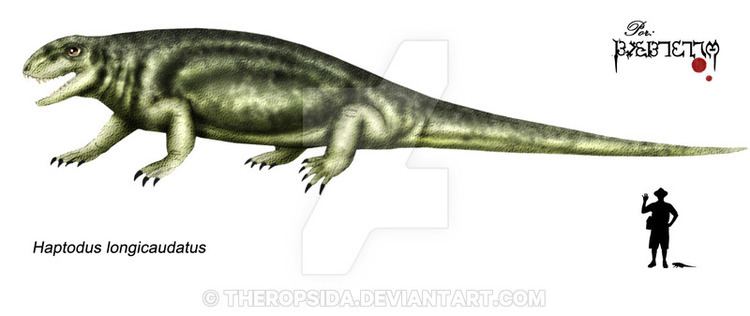Phylum Chordata | Rank Genus | |
 | ||
Similar Pantelosaurus, Sphenacodontia, Cutleria, Sphenacodontidae, Sphenacodon | ||
Haptodus is an extinct genus of basal sphenacodont, a clade that includes therapsids and hence, mammals. It was at least 1.5 metres (5 ft) in length. It lived from Latest Carboniferous to Early Permian. It was a medium-sized predator, feeding on insects and small vertebrates. H. garnettensis is currently the basalmost sphenacodontian.

Discovery and History

Haptodus baylei, the type species of Haptodus, is known only from a single, badly preserved specimen hosted in the Muséum National d'Histoire Naturelle of Paris. It was collected at Les Télots, near Autun of France, from a terrestrial horizon dating to the Asselian stage of the Cisuralian series, about 299-296.4 million years old.

H. grandis is known only from Gz 1071, a partial left maxilla, which is hosted at the Warwick County Museum. It was collected at Kenilworth of Warwickshire, England, from the Kenilworth Sandstone Formation (Warwickshire Group), dating to the earliest Asselian stage of the Cisuralian series, about 299 million years old.

H. garnettensis is the best known species of the genus. Its holotype is RM 14156, a partially articulated skeleton (cranial and postcranial) of immature individual. More than 16 well-preserved specimen of various ontological states were referred to this species. All specimens came from the Garnett Quarry, located in the Anderson County of Kansas. They were collected from the Rock Lake Member of the Stanton Formation (Lansing Group), dating to the late Kasimovian stage of the late Pennsylvanian series, about 305-303.9 million years old.
The taxonomy of many pelycosaurs was revised in details by Alfred Sherwood Romer & Llewellyn Price (1940). They synonymized many genera, including Callibrachion (from Margenne near Autun, France), Datheosaurus (from Nowa Ruda of Poland), Palaeohatteria and Pantelosaurus (both from Germany), with Haptodus, but retained these taxa as distinct species. After describing H. garnettensis in 1977, Currie (1979) synonymized all European haptodontines, as well as Cutleria wilmarthi, with the type of the genus, H. baylei. Later, Laurin (1993 and 1994) considered Haptodontinae to represent a polyphyletic grade of basal sphenacodonts, and revalidated Cutleria, Palaeohatteria and Pantelosaurus, while Callibrachion was considered to be a nomen dubium and Datheosaurus was not examined. Laurin also suggested that the type species of the genus H. baylei might be a nomen dubium, too, meaning that the only well preserved species, H. garnettensis, would have to be reassigned to its own genus. His revision has been accepted since.
